30th November 2023





Sudden Snow Storm.
1st September 2023



Malmo Quay.
A very low tide gives a good view of the arches under Malmo Quay.



Summer In The City.


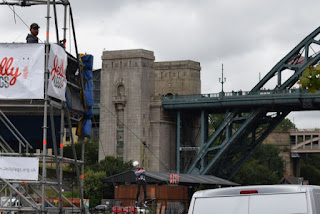



Tyne Bridge to Quayside Zipwire.
28th August 2023













Collapsing Jetty.
A couple of hundred yards west of the Redheugh Bridge opposite Dunston Staiths is a jetty that is breaking away from the main path. It started a few years back and has worsened considerably in the last couple of years. A crude attempt at filling the gap with concrete achieved little except maybe a chance to delay the inevitable, but costly, repair. I imagine it will not be long before it becomes something that has to be dealt with.

Malmo Quay.
An artist working at the mouth of the Ouseburn.

Summer In The City.
Possibly a cover to the swings or more likely infrastucture associated with the upcoming Junior Great North Run.

Zipwire Landing Stage.
Preparations for the upcoming zipwire from the southern end of the Tyne Bridge.
13th August 2023

Police Boat at Spillers Quay.
17th July 2023


Quayside West.
Laid in the 1990's when the Quayside was redeveloped the path in front of the Copthorne Hotel has a regular problem with flooding every time it rains due to it being very uneven. Makes for some great reflection photos but highlights the poor quality of the construction.
4th July 2023


Plot 12, Quayside.
One of the few remaining, as yet, undeveloped plots on The Quayside. Taken on City Road.
7th June 2023













St. Anns Wharf.
Striking U-plan office building featuring two high central stone arches. Stone top storey with long brackets supporting extended eaves. Part of Quayside regeneration from 1987 to 1998 by Tyne and Wear Development Corporation
The Dakota Hotel chain has been granted permission to redevelop the vacant offices which have been empty since 2022 when former tenants Womble Bond Dickinson moved to a new base at The Spark at Helix
Source: Sitelines.
30th May 2023




Tomahawk Restaurant (The Tyne Public House), The Milk Market.
Public house, now restaurant, 1904 by E. Bowman. Brick with ashlar dressings; Welsh slate roof. 2 storeys and attics; 4 windows.
Bracketed fascia cornice to pub front on ground floor, with corner entrance; 4 sash windows above have wide architraves and glazing bars. Eaves string, dentilled cornice. 2 dormers have sashes under pediments. Ashlar string and cornice to left end brick chimney on steeply-pitched hipped roof.
Grade 2 Listed. Source: Historic England.


Fire and Rescue Service.
7th April 2023


Quayside, no. 63.
House with shop now public house. Late C18/early C19 with c.1983 public house front. English garden wall bond brick with ashlar dressings; Welsh slate roof. 4 storeys, 4 bays. Yard entrance at left.
Wedge lintels and sill bands to sash windows, glazing bars to second and third floors; eaves band and gutter cornice. 2 end brick chimneys banded at left.
Grade 2 Listed. Source: Sitelines.


Quayside, no. 65, Coronation Buildings.
Offices. Circa 1902 for Pyman Bell and Co. Rear half demolished and front range restored c.1982. Ashlar sandstone with granite plinth and entrance columns; Welsh slate roof. Symmetrical. Art nouveau Baroque style. 3 storeys and attic; 5 windows.
Ground floor rustications form voussoirs to wide round-arched windows flanking doorway with semicircular pedimented hood on Ionic columns. Side windows plain below serpentine first-floor stone balconies.
Upper windows in architraves, first floor with triple keystones and pediments, the inner ones segmental. Second-floor rusticated architraves and Ionic half-column bay divisions. Outer bays framed in giant Ionic pilasters. Strong modillioned and dentilled top entablature below attic of three pedimented gables, the outer ones rounded.
Grade 2 Listed. Source: Sitelines.


1st January 2023









Newcastle's New Year Laser Light City.
4th November 2022


Summer In The City.
Pretty colours reflected in the low Autumn sunshine.
26th August 2022



Quayside Bridges.









Police Boat.


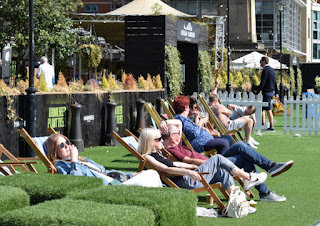



Summer In The City.





Summer In The City Zipwire.


9th August 2022

Bus Stop Removal.
I read recently that the Quaylink bus route is being altered meaning this stop is no longer needed.
16th July 2022


Litter.
In the last couple of years litter has become a serious problem across the whole city. Businesses dumping rubbish late at night doesn't help either as the seagulls always get to it before it is cleared up. Is this what we want visitors to our city see? Something as simple as using a bin would help considerably.
13th July 2022




7th July 2022

4th July 2022


Quayside, no. 9, Exchange Buildings.
Office block, incorporating No. 9-15 Lombard Street, No. 16 Queen Street and Nos. 6-10 King Street. Circa 1861 - 2 by Parnell. Rectangular block with large central light well. Basement and 4 storeys, with 5-storey central section; 3:5:3 bays x 3:10:3. Sandstone ashlar; Welsh slate roof.
Shallow central porch contains steps up to panelled double door and overlight recessed in surround of panelled pilasters and keyed arch flanked by pilasters; high plinth supports paired Tuscan columns and entablature. Above this, a tripartite window has coped balcony with Ionic columns to centre entablature breaking forward under segmental pediment; second-floor tripartite window with segmental heads and central key under pediment; shallow balcony.
Rusticated ground floor has round-headed windows, those in second bays from ends flanked by tall narrow windows in pilasters with paired brackets to first floor balustraded balcony. Ionic first- floor window surrounds under segmental pediments; floor above has similar treatment to that of centre bay.
All windows sashes, with architraves to those not in classical surrounds; those on first floor have balustraded aprons and flanking pilasters; those on second floor have segmental heads with keyed cornices; third-floor windows have round heads in the centre section, square in the outer bays, under prominent modillioned cornices on long brackets. Centre section has top cornice above plainer windows. Attics have architraves to windows except the central which is Venetian, all under alternate pediments, with intermediate balustraded parapet. Mace finials. Historical note: the site was made available by a disastrous fire.
Grade 2 Listed. Source: Sitelines.

Quayside, no. 39, Customs House.
Customs House. 1766; refronted 1833 by Sidney Smirke. Sandstone ashlar with plinth; brick left return and rear; rendered right return. Welsh slate roof with stone gable copings; brick chimneys. 3 storeys, 5 windows.
2 steps to central double 2-panelled doors and 2-pane overlight in Tuscan porch with blocking course and royal arms of period 1801-37.
Rusticated ground floor has 4 keyed arches, that at left on yard entry, others containing round-headed sashes with projecting stone sills in recessed panels. Sill panels to first floor sashes in pedimented Tuscan cases on first floor band; smaller second-floor sashes in architraves with projecting stone sills. Glazing bars of late C19 type. First floor band;fluted frieze and dentilled gutter cornice; coped parapet with pilasters. O.S. bench mark on doorcase.
Grade 2 Listed. Source: Sitelines.

25th May 2022



NE1's Summer In The City.

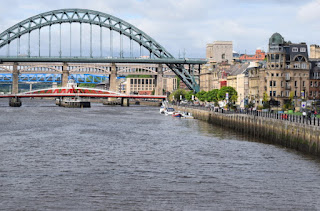






8th May 2022

CWS Warehouse (Malmaison Hotel).
This is probably the oldest surviving large scale ferro concrete building in the country. It was constructed between 1897 and 1900 by T.G. Guerrite of L.G. Mouchel's firm for the Co-operative Wholesale Society (F.E.L. Harris of CWS, architect) using the Hennebique concrete system.
The building was built on a ferro-concrete raft in places up to 6 foot thick due to the marshy silt ground conditions. The ferro-concrete raft achieved the uniform speading of the load and was calculated to resist the reaction of the ground at the rate of 2.5 tons per square foot. All the external and internal columns, floors, walls and roof were also constructed in ferro-concrete. The building had eight floors. A further storey with a barrel vault roof was added in 1901.
Grade 2 Listed. Source: Sitelines.

23rd March 2022


The Golden Globe Monument.
The Swirle Pavilion, with its golden globe, is part folly and part sculpture. It was made by Raf Fulcher in 1998. The names around the inside are some of the cities with which Newcastle regularly traded from boats on the Quayside.
The Swirle, and the short street that runs down towards it, are named after the Swirle (or Squirrel) Burn, now hidden, which used to separate the two towns of Newcastle and Byker.

NE1's Summer In The City.

H.M.S. Magpie.


Taken from Gateshead.
20th January 2022

NE1's Summer In The City.

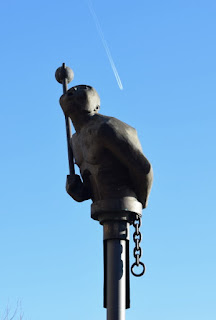
River God, Sandgate.
1996 by Andre Wallace. Bronze brown-patinated figure of a male head and torso on top of a steel column. He holds a staff and chain and appears to be blowing at the nearby 'Siren' figure by the same artist. Commissioned by the Tyne and Wear Development Corporation.


King Street, no. 25.
Offices, now restaurant. Circa 1890. Sandstone ashlar; Welsh slate roof. 4 storeys and attic, 8 bays; Jacobethan style.
Leaded casements in stone mullioned-and-transomed cross windows. Paired pilasters flanking 2 bays at each end, those on ground floor Tuscan order with paterae; Ionic Order above; Corinthian on third floor, all with full-width entablatures with pulvinated friezes; egg-and-dart-moulding to ground-floor cornice, dentils to first and modillions to second.
2 dormers have similar windows in keyed arched recesses flanked by consoles and under segmental pediments. Parapet with pilasters; 2 segmetal-headed dormers. One-bay right return to Quayside has similar dormer with consoles giving shaped gable effect.
Grade 2 Listed. Source: Sitelines.
14th December 2021


Plot 12, Quayside.
One of the few remaining, as yet, undeveloped plots on The Quayside.



St. Ann's Quay.


St. Ann's Wharf.


Rotterdam House.


The Swirle.
Small lane between Sandgate and the Quayside. Shown on Hutton's map of 1770 as 'Swerle'. The street name was derived from the stream, the word 'swirle' meaning the meandering of a stream of water.
The 66th boundary stone of the borough of Newcastle stood at the north-west corner of the Swirle. Bourne records that the street was sometimes known as the Squirrel. There was a fine block of old buildings in the Swirle with Queen Anne gables, tall chimney stacks and dormer windows. One of them was the Half Moon Tavern.
Source: Sitelines.

Wrangham's Entry, Sandgate.
19th C. alleyway first noted on Ordnance Survey second edition.






Sandgate.
There is little information to suggest that there was any substantial growth of suburbs outside the main gates in the later middle ages, but there was at least some development along Sandgate. It is difficult to be sure when Sandgate emerged. Land in Sandgate is mentioned as early as 1336, but as late as 1425 there were tofts runnings from Wallknoll Close to the river, with Sandgate existing only as a right of way across them.
The first reference to building on the south street frontage is in 1487. However 15th century-16th century pottery, walls and cobbled surfaces were found below 14 feet of ballast sand in 1972, suggesting that Sandgate, as it began to develop in the 16th century as shown on Speed's map of 1610, represents a re-planning probably on the earlier line.
Gray reported that by 17th century outside the medieval Sand Gate there were many houses, all along the waterside, where shipwrights, seamen and keelmen lived. Bourne adds that the name comes from the fact that this area is made up of sand. The narrow lanes (chares) on either side of Sandgate were crowded with houses. Several thousands of people lived here.
Source: Sitelines.


Siren, Sandgate.
Siren, 1996, by Andre Wallace.



CWS Warehouse (Malmaison Hotel).




Keelmen's Square.

The Golden Globe Monument.

Quayside, Nos. 77 and 79, Baltic Chambers.
Offices. Early C20. Sandstone ashlar; roof not visible; ashlar-corniced grey brick chimney. Asymmetrical. Second-Empire classical style. 4 storeys, 2 bays, the right narrow with round-arched entrance holding internal flight of 4 steps to panelled double door.
Ground floor rusticated. Shop front at left with cellar shute below. Upper windows sashes, those on first and second floors paired in left bay, with chamfered reveals and moulded segmental heads. Bowed ornamental aprons between floors.
Giant flat pilasters support quasi-entablature at third floor level, above which they are rusticated and bifurcated up to top entablature; third floor sashes in architraves, triple in left bay.
Grade 2 Listed. Source: Sitelines.



Love Lane Warehouses, Milk Market.
Warehouse, now housing. Circa 1830 and later. English bond brick with ashlar basement and dressings; felt-covered roof. Basement and 5 storeys; 13 bays.
Partly bricked up loading bays in fourth and tenth bays under low-pitched gables. First bay vehicle entrance with voussoirs and segmental arch; and boarded door in deep reveal. Segmental brick arches and projecting stone sills to horizontal sliding sashes with vertical glazing bars and overlapping panes. Rounded right corner and tall,round ashlar-corniced steam mill chimney, a later C19 addition.
Grade 2 Listed. Source: Historic England.
9th December 2021
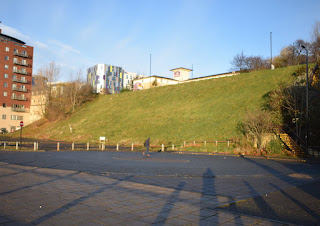
Plot 12, Quayside.

The Swirle.

Wrangham's Entry, Sandgate.

Spencer's Entry, Sandgate.
C13-C15 alley shown on Ordnance Survey second edition.


Flag Chare, Sandgate.
Flag Chare forms a narrow lane between The Los Iguanas restaurant in Keelmen's Square and the modern Quayside House.

Anchor Chare, Sandgate.
A narrow lane running down the eastern side of C.W.S. Warehouse (Malmaison Hotel).


NE1's Summer In The City.

The Law Courts.
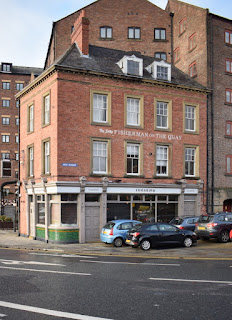
Tomahawk Restaurant (The Tyne Public House), The Milk Market.





Love Lane Warehouses, Milk Market.



Cox Chare, The Milk Market.
Road leading from Pandon to Quayside, it was previously much narrower with many warehouses.


Trinity Chare.
The Quayside plateau has its origin in an episode of land reclamation in the 13th century. By the end of that century the arrangement of streets had been established and to a great extent that arrangement still survives. Buildings have been replaced at intervals on the same sites since the first houses of the 13th century.
Presevation of 13th century buildings below ground is exceptionally good, with walls surviving to a height of some 2m. There were no minor streets or chares running off the Quayside before 1376, although the word "Key" is used four times from 1332 to 1366. From Sandhill to Sandgate there were 20 chares which survived until the mid C19. Most were so narrow that two people could not walk abreast. Their date of origin is unknown, earliest reference is C14.
Source: Sitelines.




Quayside, No. 39, Customs House Yard.
Previously known as Peacocks Chare.

Quayside, nos. 25 and 27, Broad Garth House.
Shop and offices, now offices. 1869 by John Wardle for W.C. Brown. Sandstone ashlar; Welsh slate roof. 4 storeys and attics, 4 windows.
Office entrance at right has renewed double door and fanlight in quadrant-moulded arched surround with keystone and alternately - rusticated voussoirs. Former shop has renewed glazing and blocked door with window inserted.
Chamfered pilasters support ground-floor cornice. Sash windows on upper floors, with lintel band, chamfered above windows, to rusticated first floor, and 8 carved tympana above. Second floor has recessed abacus and coved recessed strips flanking windows and between bays, with Italian Gothic carving to 8 panels above. Prominent second-floor cornice. Plain reveals to third-floor sashes; end pilasters with mask brackets. Mace-head finials to top cornice and to central dormer with Diocletian window. Steeply-pitched hipped roof.
Grade 2 Listed. Source: Sitelines.


King Street, no. 25.


Plummer Chare.
One of the ancient alleyways at the side of 25, King Street above.


Broad Garth.
Another of the many ancient alleyways (Chares) on the Quayside. Entry to Broad Garth is located under no. 25-27, Quayside.


4th November 2021




King Street, no. 25.

Quayside, nos. 77 and 79, Baltic Chambers.


Quayside, no. 65, Coronation Buildings.

Quayside, no. 63.

Quayside, nos. 55-57, Live Works.
Tech company ZeroLight occupy this part of the modern addition to the Quayside.


Quayside, no. 39, Customs House.

Quayside, nos. 25 and 27, Broad Garth House.


Quayside, nos. 15 to 23, Mercantile Buildings.
Offices. 1883 by J. C. Parsons for Thomas Harper. Sandstone ashlar; roof of Welsh slate. 3 storeys and attics, 7 bays. 3 internal steps up to central double door in architrave; right end entrance to yard behind has round arch with voussoirs and keystone.
Architraves to all windows, sashes paired except in end and centre bays. Deep cyma moulding to plinth between pilasters to ground floor sill band.
Upper floors have sill strings. Each floor has entablature, with frieze pulvinated above windows, door and yard arch. Wreath carving on frieze above paired windows, which have pediments to each pair, segmental on first floor, (except top floor which has dentilled cornice breaking forward over windows, and small segmental pediments). High panelled and coped roof parapet with end urn finials; 2 paired dormers in entablature under carved pediments with cartouches.
Grade 2 Listed. Source: Sitelines.


Quayside, no. 9, Exchange Buildings.


Blacksmiths Needle.
1996 by Members of the British Association of Blacksmith Artists. A forged steel cone in six sections. Each section contains objects, mostly with a maritime theme, which relate to one of the senses. The work was inaugerated in May 1997 by Evelyn Glennie, a percussionist, ringing the bell which hangs inside the needle.

Love Lane Warehouses, The Milk Market.


Former Co-op warehouse now the Malmaison Hotel.
4th October 2021

NE1's Summer In The City.
12th August 2021













NE1's Summer In The City.
2nd July 2021

Taken outside The Free Trade Inn.

The old C.W.S. warehouse now The Malmaison Hotel.




21st June 2021


The Port of Tyne's Clearwater.
Clearwater removes around 400 tonnes of debris from the river between Blaydon and the piers each year.
15th June 2021

HMS Calliope.
MS Calliope training centre, located across the Tyne in Gateshead.


7th June 2021

Taken just under Horatio Street.
11th May 2021

Sage Gateshead.

Panoramic view of Newcastle and Gateshead Quayside.
5th May 2021

Kill The Bill sticker on the Quayside.

Taken outside The Pitcher and Piano.




23rd April 2021


The Milk Market.


10th February 2021


A couple from my Quayside (Snow) page.
26th January 2021

Horatio St, Blenkinsopp-Coulson Drinking Fountain.
Drinking fountain and portrait bust. 1914; signed Alexis Rudier and bust dated 1912. Sandstone, pink granite and bronze. Wide stone base; granite plinth and basins; sandstone pedestal with long inscription commemorating W.L. Blenkinsopp Coulson and his efforts to help the weak and defenceless 'among mankind and in the animal world'.
Larger-than-life bust has drapery wrapping round pedestal. Has two fountain bowls - one for humans, one for animals.
The fountain originally stood in Percy Street before being moved to the Haymarket then in 1950 to its present site. Statue to William Lisle Blenkinsopp-Coulson 1841-1911. Erected by public subscription. Bronze bust by A. Rechbers and cast by Alexis Rudier, Paris, surmounts a sandstone pedestal. There are two new rather crudely carved animal heads. The originals will have faucets discharging from the mouths of the beasts. There is now no water supply.
Grade 2 Listed. Source: Sitelines.

11th January 2021


St. Lawrence Road, Free Trade Inn.
The former beerhouse probably opened shortly after the introduction of the 1830 Beer Act. Bought by Henry Davidson of the White Lion Brewery in 1888. Rebuilt in 1896 to designs by Oswald and Son.
Their original design had two large decorative gables in Queen Anne revival style with ball finials and hooded canopy over the door. Inside the bar had a V-shaped counter to echo the shape of the building. There was a club room upstairs. Henry Davidson opted for a cheaper design which increased the size of the tenant's accomodation and replaced the proposed club room with bedrooms. The façade hardly had any decoration apart from facings round the windows and a parapet inscribed with the name Free Trade.
In 1899 Matthew Wood, brewer from South Shields bought it. In 1911 there were structural alterations. The tenant's kitchen became a parlour, the bar counter was extended and the family room became part of the main bar.
In 1919 the Free Trade became a Newcastle Breweries pub. In 1937 more internal partitions were removed. It almost closed in 1947 when Newcastle Breweries applied to transfer the licence to a new pub to be built in Sackville Road. The Free Trade was not granted a full publican's licence until 1963. It is still a free house. Little of the original interior survives apart from the basic form of the bar counter and part of the back bar fitting.
Source: Sitelines.
2nd January 2021

Free Trade Inn.






22nd December 2020
Quayside from Byker.
15th November 2020
Quayside, Plot 12.
There has been much debate in recent years about what will be built here.
East Quayside.
The River Escapes ferry which runs cruises up and down the river Tyne.
CWS Warehouse (Malmaison Hotel).
Quayside, no. 9, Exchange Buildings.
King Street, Quayside.
Quayside, no. 39, Customs House.
The Quayside.
Quayside East.
The mouth of the river Ouseburn on the right.
17th October 2020

Malmo Quay.
A very early morning exercise group going through their paces.
12th October 2020
Near the mouth of the river Ouseburn.
29th September 2020
The Golden Globe Monument.
The Blacksmith's Needle.
The Blacksmith's Needle is a slim cone-shaped tower of open metal-work. The sculpture was created in 1998.
It has a multitude of hand-forged iron and steel objects welded all over the frame. Most of the items have a predominately maritime theme, so the sculpture fits in with the overall concept for the quayside area. The 'Needle' comprises of six layers, each layer with objects relating to the senses including what was describes as 'the mysterious sixth sense'.
21st September 2020



Sandhill.
The Tyne threatens to burst it's bank underneath the Swing Bridge.
The Law Courts.
Hadrian's Wall Path Collapse, Skinnerburn Road.
A recent collapse of the path bordering the big wooden jetty west of the Redheugh Bridge.
Bridges galore.
The Quaylink bus.
Sandhill.
'River Escape' Ferries.
The Quayside.
The Quayside looking it's best with a calm river Tyne and plenty of sunshine.
3rd September 2020
'River Escape' Ferries.
The Port of Tyne's 'Clearwater'.
Clearwater removes around 400 tonnes of debris from the river between Blaydon and the piers each year.
Early morning Joggers.
3rd August 2020
'River Escape' Ferries.
Quayside, no. 9, Exchange Buildings.
King Street.

Quayside Marina.
The Pitcher and Piano.
Sandhill.
Bridges galore.
HMS Calliope, Royal Naval Reserve Unit.
Malmo Quay.
Wesley Square.
The Millennium Bridge.
21st July 2020
Malmo Quay.
The Millennium Bridge from Malmo Quay.
16th June 2020
Early morning deserted Quayside.
28th May 2020
Sandgate.
The Golden Globe Monument.
The Swirle Pavilion, with its golden globe, is part folly and part sculpture. It was made by Raf Fulcher in 1998. The names around the inside are some of the cities with which Newcastle regularly traded from boats on the Quayside.
The Swirle, and the short street that runs down towards it, are named after the Swirle (or Squirrel) Burn, now hidden, which used to separate the two towns of Newcastle and Byker.
Gateshead Quays.
Taken from Tyne Street.
Taken outside the Free Trade Inn.
Early morning on the Quayside.
26th March 2020
'River Escape' Ferries.
Horatio Street.
Taken from Spillers Quay.
Taken from Malmo Quay.
6th March 2020
Taken from Ouseburn Schools on Walker Road.
January 2020
Sunrise.
A very early walk without a tripod.
My other photos around the Quayside:
- Broad Chare
- Close
- Horatio Street, Sailors Bethel
- Newcastle Tall Ships Race (2005)
- Nothing Serious (Mural)
- Quayside (2005 to 2009)
- Quayside (2010 to 2013)
- Quayside (2014 to 2017)
- Quayside (2018 to 2019)
- Quayside (2024 onwards)
- Quayside (Fog)
- Quayside (Panoramic Photographs)
- Quayside (Reflections)
- Quayside (Snow)
- Quayside (Sunset)
- Quayside Bridges, Bamboo Bridge (2008)
- Quayside Bridges, High Level Bridge
- Quayside Bridges, King Edward VII Bridge
- Quayside Bridges, Millennium Bridge
- Quayside Bridges, Millennium Bridge Bollards Removal
- Quayside Bridges, QE II Bridge (Metro Bridge)
- Quayside Bridges, Redheugh Bridge
- Quayside Bridges, Swing Bridge
- Quayside Bridges, Tyne Bridge
- Quayside Marina
- Quayside Market
- Quayside Seaside
- Sandhill
- Sandhill, Guildhall
- Side & Akenside Hill
- Spillers Quay & Malmo Quay











































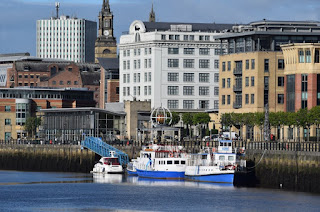

























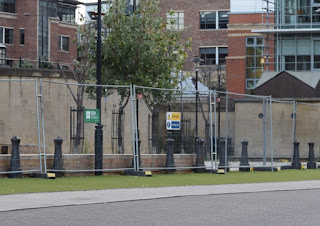


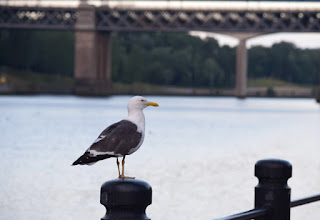



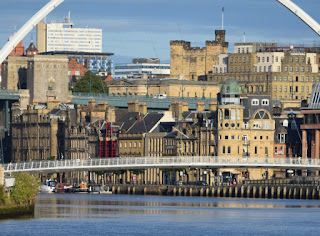



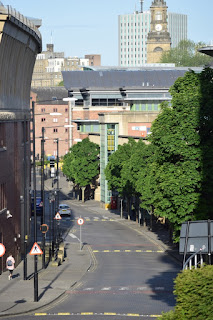



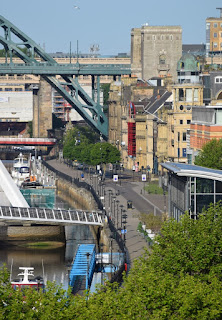
































No comments:
Post a Comment